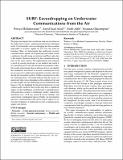| dc.contributor.author | Mollahosseini, Poorya | |
| dc.contributor.author | Afzal, Sayed Saad | |
| dc.contributor.author | Adib, Fadel | |
| dc.contributor.author | Ghasempour, Yasaman | |
| dc.date.accessioned | 2025-01-24T21:21:13Z | |
| dc.date.available | 2025-01-24T21:21:13Z | |
| dc.date.issued | 2024-12-04 | |
| dc.identifier.isbn | 979-8-4007-0489-5 | |
| dc.identifier.uri | https://hdl.handle.net/1721.1/158064 | |
| dc.description | ACM MobiCom ’24, November 18–22, 2024, Washington D.C., DC, USA | en_US |
| dc.description.abstract | This paper investigates how an airborne node can eavesdrop on the underwater acoustic communication between submerged nodes. Conventionally, such eavesdropping has been assumed impossible as acoustic signals do not cross the water-air boundary. Here, we demonstrate that underwater acoustic communications signals can be picked up and (under certain conditions) decoded using an airborne mmWave radar due to the minute vibrations induced by the communication signals on the water surface. We implemented and evaluated a proof-of-concept prototype of our method and tested it in controlled (pool) and uncontrolled environments (lake). Our results demonstrate that an airborne device can identify the modulation and bitrate of acoustic transmissions from an uncooperative underwater transmitter (victim), and even decode the transmitted symbols. Unlike conventional over-the-air communications, our results indicate that the secrecy of underwater links varies depending on the modulation type and provide insights into the underlying reasons behind these differences. We also highlight the theoretical limitations of such a threat model, and how these results may have a significant impact on the stealthiness of underwater communications, with particular concern to submarine warfare, underwater operations (e.g., oil & gas, search & rescue, mining), and conservation of endangered species. Finally, our investigation uncovers countermeasures that can be used to improve or restore the stealthiness of underwater acoustic communications against such threats. | en_US |
| dc.publisher | ACM|The 30th Annual International Conference on Mobile Computing and Networking | en_US |
| dc.relation.isversionof | https://doi.org/10.1145/3636534.3690663 | en_US |
| dc.rights | Creative Commons Attribution | en_US |
| dc.rights.uri | https://creativecommons.org/licenses/by/4.0/ | en_US |
| dc.source | Association for Computing Machinery | en_US |
| dc.title | SURF: Eavesdropping on Underwater Communications from the Air | en_US |
| dc.type | Article | en_US |
| dc.identifier.citation | Mollahosseini, Poorya, Afzal, Sayed Saad, Adib, Fadel and Ghasempour, Yasaman. 2024. "SURF: Eavesdropping on Underwater Communications from the Air." | |
| dc.contributor.department | Massachusetts Institute of Technology. Department of Electrical Engineering and Computer Science | en_US |
| dc.contributor.department | Program in Media Arts and Sciences (Massachusetts Institute of Technology) | en_US |
| dc.identifier.mitlicense | PUBLISHER_CC | |
| dc.eprint.version | Final published version | en_US |
| dc.type.uri | http://purl.org/eprint/type/ConferencePaper | en_US |
| eprint.status | http://purl.org/eprint/status/NonPeerReviewed | en_US |
| dc.date.updated | 2025-01-01T08:46:53Z | |
| dc.language.rfc3066 | en | |
| dc.rights.holder | The author(s) | |
| dspace.date.submission | 2025-01-01T08:46:53Z | |
| mit.license | PUBLISHER_CC | |
| mit.metadata.status | Authority Work and Publication Information Needed | en_US |
